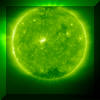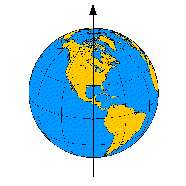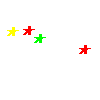|
A. The Sun: Earth’s Star
1) Star
(a) Huge sphere of glowing hot gases
(b) Medium size
(c) Rotation – 4 weeks
2) Parts of the sun
(a) Photosphere
(1) Bright, visible surface of the sun
(i) Granules
1. Small light and dark areas
2. Movement of gases
3. Dark – cooler
(ii) Sunspots
1. Large dark cooler regions
2. Number varies from 11 – 13 years
(b) Chromosphere
(1) Thin, red layer above photosphere
(c) Corona
(1) Outermost layer
(d) Prominences
(1) Stream of gas shooting up from the sun
(e) Solar flares
(1) Sudden eruptions of gases that travel far into space
(f) Solar wind
(1) Constant streaming of particles from the sun into space
3) Sun’s interior
(a) Core
(1) Gas
(i) Held in sphere by gravity
(2) 15 million ºC
(3) Nuclear fusion
(i) Joining of hydrogen atoms
1. Forms helium
|

The Sun |

Parts of the Sun |

Faculae - large, bright regions |

Solar
Arcs |

Solar Flare |
|

The corona of the Sun is a large, white halo of glowing gas visible
during a total eclipse. The corona gas is extremely hot (temperatures
on order of a million degrees) and is the source of the solar wind.
The solar wind is a constant stream of solar particles moving at faster than
the escape velocity of the Sun's gravitational field. They escape
through windows in the solar corona called coronal holes, regions where the
magnetic fields are weak and the charged solar wind particles are not
trapped in magnetic bottles. |

Sunspots |
 The
ultra-violet picture of the corona shows that the hot gas is connected to
the magnetic features in the photosphere. These low level structures
extend into long streamers in the outer corona and heat the corona to its
million degree temperature. The
ultra-violet picture of the corona shows that the hot gas is connected to
the magnetic features in the photosphere. These low level structures
extend into long streamers in the outer corona and heat the corona to its
million degree temperature. |
|
B. Day and Night on Planet Earth
1) Rotation
(a) Axis
(1) Imaginary line through poles of earth
(b) Proof
(1) Pendulum swing
(2) Missile path
(3) Space
(c) Time
(1) Position of the sun in sky
(2) Time zones
(i) A longitude belt, 15º wide
2) Night lights
(a) Aurora
(1) Matter and energy from sun interact with atmospheric gases
(2) Occur mainly at poles
(i) Magnetic field
1. Region around a magnet where a magnetic force is felt
(3) Magnetosphere
(i) Area of space affected by the Earth's magnetic field
(ii) Van Allen Belts
1. Discovered January 31, 1958 by Explorer I
2. James Van Allen |

The line you see above is the Earth's
axis. The Earth's rotation axis precesses, i.e. it exhibits a slow,
conical motion around the orbital axis.
Precession is the same effect you see with a top.
As long as it is spinning, the top does not fall over, and likewise the
Earth's axis won't straighten. |
|
 |
Van Allen Belts
|
 |
|

Aurora |

World Time Zone Map |

3D View of the
Earth's Magnetosphere |
|
C. Earth’s Orbit and Seasons
1) Revolution
(a) Time it takes to complete one orbit around the sun
(b) Proof
(1) Parallax
(i) Shift in an objects position when viewed from two locations
|

Earth's Revolution
|
|
Parallax of Stars
(you may need to
refresh page to get the two pictures in sync)

 The
image above shows a top view of the Earth's orbit about the Sun and our view
of a nearby star against a more distant star field. The image on the
side shows how the star "moves" against the background stars during the
course of when observations were taken. Together, these images provide
a visual representation of parallax. Note: the motion of the
star has been greatly exaggerated - remember that stars are at extreme
distances; hence, their actual movement is small. The
image above shows a top view of the Earth's orbit about the Sun and our view
of a nearby star against a more distant star field. The image on the
side shows how the star "moves" against the background stars during the
course of when observations were taken. Together, these images provide
a visual representation of parallax. Note: the motion of the
star has been greatly exaggerated - remember that stars are at extreme
distances; hence, their actual movement is small. |
|
2) Seasons
(a) Tilt of axis
(1) 23 ½º
(b) Summer
(1) Summer solstice
(i) June 21/22
(ii) Sun’s path highest in sky
(iii) Longest day
(c) Fall
(1) Equinox
(i) September 22/23
(ii) Equal hours of day and night
(d) Winter
(1) Winter solstice
(i) December 21/22
(ii) Sun’s path lowest in sky
(iii) Shortest day
(e) Spring
(1) Equinox
(i) March 20/21
(ii) Equal hours of day and night
3) Time adjustments
(a) Leap year
(b) Daylight savings time
(1) Not nation-wide
|

Earth's Seasons |
|

Northern Hemisphere

Southern Hemisphere |

Born on February
29th??
Click above!
|
|
D) The Moon: Earth’s Satellite
1) Nearest neighbor
(a) Mare
(1) Galileo called them “seas”
(2) Dark, wide flatlands
(b) Rays
(1) Trails of rock and dust extending from craters
(c) Mountains and ridges
(d) Highlands
(1)
White areas
2) Phases
(a) Changes in the moon’s shape
(b) New moon
(1) Moon between sun and earth
(2) No light
(c) Crescent moon
(1) Thin sliver of moon has light
(d) Quarter moon
(1) One half of the moon has light
(e) Gibbous moon
(1) Almost totally lit
(f) Full moon
(1) Moon is totally lit
3) Eclipses
(a) Moon is not in same plane as earth
(b) Solar eclipse
(1) Earth passes through Moons shadow
(2) Penumbra
(i) Lighter part of shadow
(ii) Sunlight not totally blocked
(3) Umbra
(i) No sunlight at all
(c) Lunar eclipse
(1) Moon passes through Earth’s shadow
|

Interior of Moon |
|

Mare & Highlands
|
|

Kepler Crater with
Rays |
|

Surface Features
 |
|

Moon Going Into
Eclipse |
![]()